Taxus baccata
As you can know long time ago bows were the most important weapon cause no guns were then.
And Polish yews were cut enormously and sold abroad for making excellent bows. You can read this all in English language sources beneath (except of the info about Polish king of course).
I would also like to present some pictures of yew taken from free on-line library of one of regional offices. I think they are really nice and I have to use them here instead of mine cause I don't take any pictures of trees. I simply don't deal in trees. They are out of my field of interest mostly cause I am not any forester, I am afraid.
As you can read in English language resourses yew was regarded as holly tree by Druids.
As you can read everywhere else - take care cause yew is a poisonous plant:(
What more can I write in this particular place is that:
1. as you can see it is very useful thing to know English and read about many facts from English language resources :)
2. is it possible that famous Robin Hood had bows made from Polish yews? Could he afford it or - on the contrary- were they cheaper than Sherwood's ones?
3. though I like British culture (especially history and literature) very much I cannot resist to criticize here human general stupidity and lack of respect for wildlife - that is equally characteristic to all people around the world but it is quite different issue as I think -cause everyone knows that there are simply no forests nowadays in Great Britain cause all forests have been cut out there:(((
Here read more about yew:
WIKIPEDIA:
Taxus baccata is a conifer native to western, central and southern Europe, northwest Africa, northern Iran and southwest Asia. Originally and still widely known in English as just Yew, the later discovery of other very similar related species has led to qualification as European Yew, Common Yew or English Yew where detail of which species of Taxus is required. The word yew is from Proto-Germanic *īwa-, possibly originally a loanword from Gaulish ivos, compare Irish ēo, Welsh ywen, French if; see Eihwaz for a discussion).
It is a small to medium-sized evergreen tree, growing 10-20 m tall, exceptionally up to 28 m. It is relatively slow growing, but can be very long-lived, with the maximum recorded trunk diameter of 4 m probably only being reached in around 4,000 years.
It has thin scaly brown bark. The leaves are lanceolate, flat, dark green, 1-4 cm long and 2-3 mm broad, arranged spirally on the stem, but with the leaf bases twisted to align the leaves in two flat rows either side of the stem except on erect leading shoots where the spiral arrangement is more obvious.
The seed cones are highly modified, each cone containing a single seed 4-7 mm long partly surrounded by a modified scale which develops into a soft, bright red berry-like structure called an aril, 8-15 mm long and wide and open at the end. The arils are mature 6-9 months after pollination, and with the seed contained are eaten by thrushes, waxwings and other birds, which disperse the hard seeds undamaged in their droppings; maturation of the arils is spread over 2-3 months, increasing the chances of successful seed dispersal. The male cones are globose, 3-6 mm diameter, and shed their pollen in early spring. It is mostly dioecious, but occasional individuals can be variably monoecious, or change sex with time.
All parts of the tree are highly toxic, except the bright red aril surrounding the seed, enabling ingestion and dispersal by birds.
Uses and traditions
In the ancient Celtic world, the yew tree (*eburos) had extraordinary importance; a passage by Caesar narrates that Catuvolcus, chief of the Eburones, virtually "sons of the yew", poisoned himself with yew rather than submit to Rome (Gallic Wars 6: 31).
Similarly, Florus notes that when the Cantabrians were under siege by the legate Gaius Furnius in 22 BC, most of them took their lives either by the sword or by fire or by a poison extracted ex arboribus taxeis, that is, from the yew tree (2: 33, 50-51). In Hispania, Prudentius (Contra Simacum 2: 1005-1011) and Martin of Braga in Visigothic times (De correctione rusticorum 8) denounced the fact that the Hispanic country folk still worshipped trees and sacred stones (Simón 2005).
The yew is often found in churchyards from England and Ireland to the Asturias (Simón ref); some of these trees are exceptionally large (over 3 m diameter) and likely to be over 3,000 years old, long predating the churches they are beside and betokening an earlier sacred site. Many believe that the enormous sacred evergreen at the pagan Temple at Uppsala was a yew. The Christian church commonly found it expedient to take over these existing sacred sites for churches. It is sometimes suggested that these were planted as a symbol of long life or trees of death. An explanation that the yews were planted to discourage farmers and drovers from letting their animals wander into the burial grounds, with the poisonous foliage being the disincentive, may be intentionally prosaic.
Yew is also associated with Wales because of the longbow, an early weapon of war, developed in Wales. Yew is the wood of choice for longbow making, which are constructed so the heartwood of yew is on the inside of the bow while the sapwood is on the outside. This takes advantage of the natural properties of yew wood since the heartwood is able to withstand compression while the sapwood is elastic and allows the bow to stretch. Both tend to return to their original straightness when the arrow is released.
Yews are widely used in landscaping and ornamental horticulture. Well over 200 cultivars of Taxus baccata have been named. The most popular of these are the "Irish Yew" (Taxus baccata 'Fastigiata'), a fastigiate cultivar of the European Yew, and the several variants with yellow leaves, collectively known as "Golden Yew". A special use of the yew is for topiary garden sculpture, a use not uncommon for many of the more elaborate gardens of England and Scotland.
The chemotherapy drug docetaxel is derived from Taxus baccata.
No tree is more associated with the history and legends of Great Britain than the Yew. Before Christianity was introduced it was a sacred tree favoured by the Druids, who built their temples near these trees - a custom followed by the early Christians. The association of the tree with places of worship still prevails.
Many cases of poisoning amongst cattle have resulted from eating parts of the Yew.
Constituents
The fruit and seeds seem to be the most poisonous parts of the tree. An alkaloid taxine has been obtained from the seeds; this is a poisonous, white, crystalline powder, only slightly soluble in water; another principle, Milossin, has also been found.
Uses
The wood was formerly much valued in archery for the making of long bows. The wood is said to resist the action of water and is very hard, and, before the use of iron became general, was greatly valued. (In homoeopathy a tincture of the young shoots and also of the berries is used in a variety of diseases: cystitis, eruptions, headache and neuralgia, affections of the heart and kidneys, dimness of vision, and gout and rheurmatism.
And watch some net-taken nice pictures from yew-protecting nature reserves in my district:
1. big yew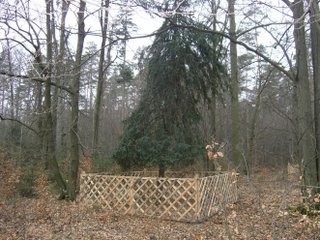 2. little yew
2. little yew 3. yew fruits
3. yew fruits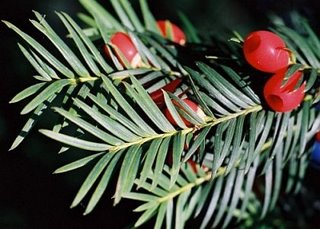 4. trunk with mosses and yews around and in the background
4. trunk with mosses and yews around and in the background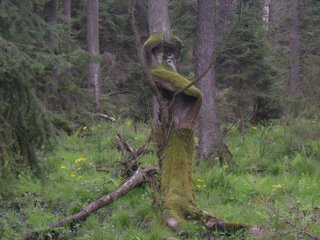 5. marshy ground where yews grow (in the background)
5. marshy ground where yews grow (in the background)
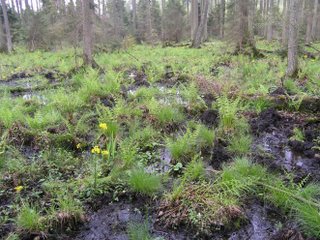
6. dead yews and alive ones nearby the river. Nature reserves are the only places where you can meet wonderful, dead trees untouched, decaying in peace. Mostly forests are artificial and dead trees are cleaned at once:((( No pivotal forests here mostly:(((

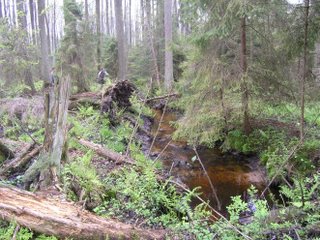
0 Comments:
Post a Comment
<< Home